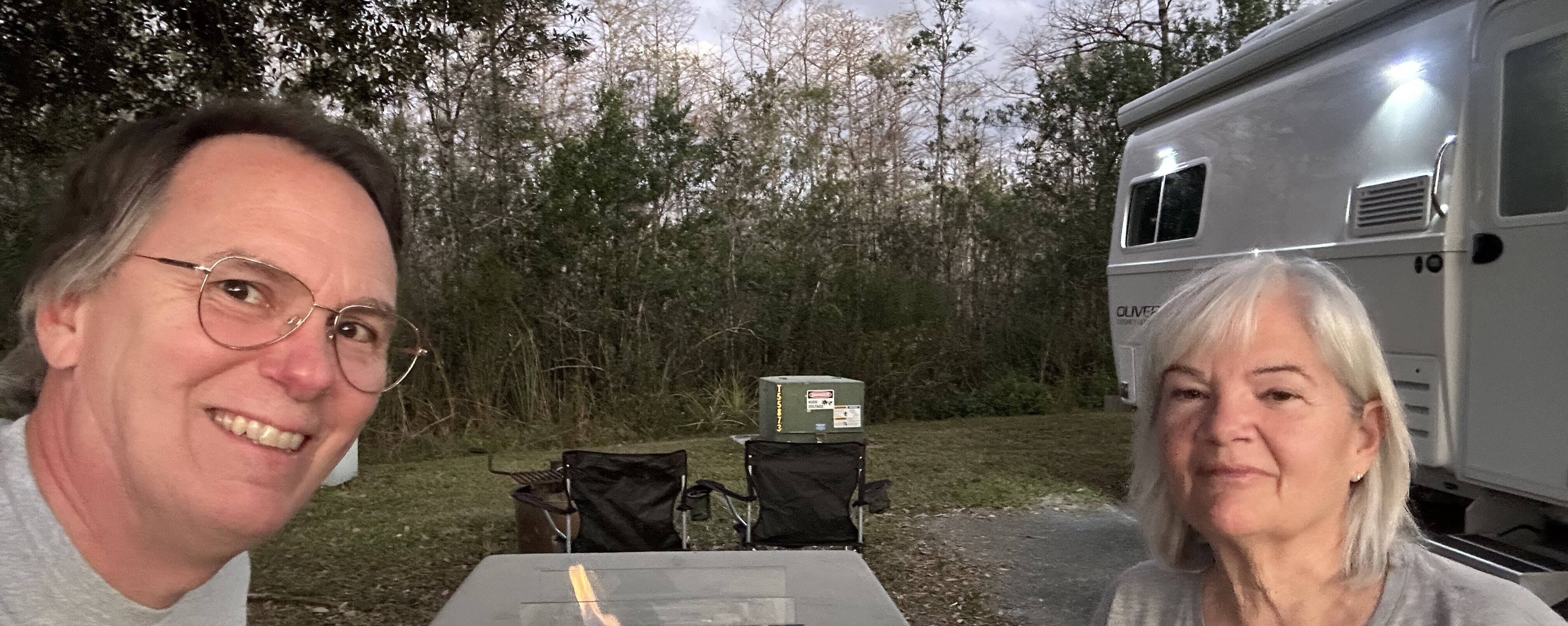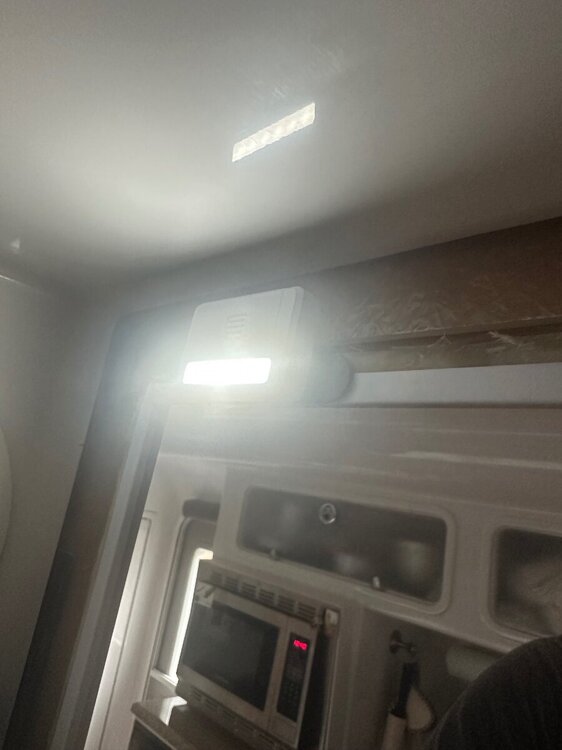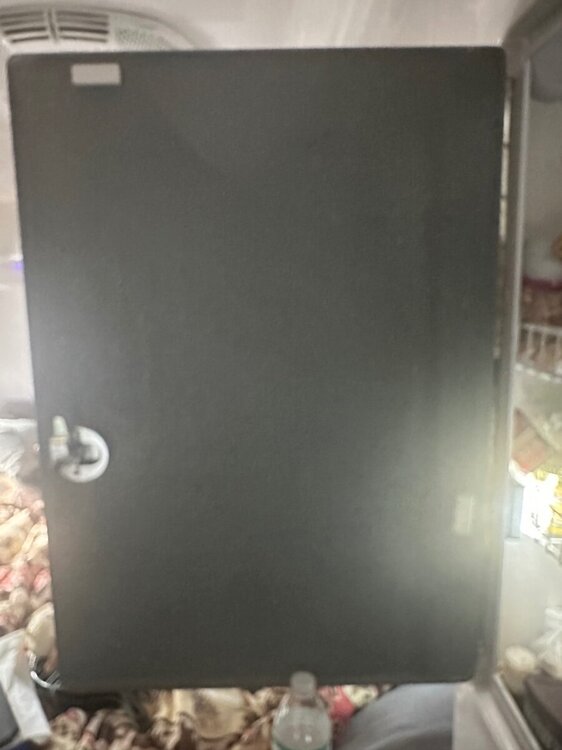
Galileo
Member+-
Posts
252 -
Joined
-
Last visited
-
Days Won
5
Everything posted by Galileo
-
Andersen WD Hitch Periodic Maintenance?
Galileo replied to Galileo's topic in Mechanical & Technical Tips
I’m with you 98% except for tires where often OEM is satisfactory and better performance can be found easily. True - OEM tires can be “just OK” and I’m sure better ones can be found - usually for more $$$. (Which explains why the factory put on the ones they did!) OTOH - pretty sure those Firestone Transport 500 tires that failed and caused several fatal rollover accidents were OEM - but I think they traced that to faulty construction that allowed the belts to delaminate. I guess the times I’ve put tires on newer vehicles, I just hadn’t done adequate research into the “better” tires, so I defaulted to the research that the factory did. Call me lazy. Previous to my two tow vehicles purchase new, my old vehicles were second, third, who-knows-how-many owner vehicles. For those, anything remotely round that held air was deemed “tire”. 😋 -
On a whim I occasionally press the “Battery” button on the see-level display. Usually I see 13 point something. Last night, plugged into shore power with all AC accessories working and no error messages, with the furnace fan running, I pressed it and it read “12.3. I thought - seems low, but don’t panic. When the furnace fan shut off, I pressed it again and it had come up to 12.4. Still low, but not knowing what strategy the battery charger uses, I let it go for the moment. About six in the morning, a memory of this happening previously came to mind. That time I pulled out my Fluke 77 and checked the actual voltage at a few cigarette lighter sockets and they all agreed with the see-level display. I checked the battery charger breaker and it was on. I pulled the cushion off the rear dinette seat and lifted the access panel… Battery charger unplugged. Sure enough, when I arose and looked - same thing. That’s twice for the battery charger. First season out, the Norcold fridge wouldn’t automatically switch to AC when we arrived at our campground with hookups. It stayed on LP mode. I pulled the outside lower cover and found zero voltage at the AC connection. About the time that Oliver service got back to me, I had found the AC plug under the galley cabinets had come unplugged. I think that’s when I asked myself “why isn’t this hardwired?” Now I’m asking the same about the battery charger… Only reason I can think of is “Manufacturer’s warranty”. So - check those plugs! Anybody address this issue?
-
Andersen WD Hitch Periodic Maintenance?
Galileo replied to Galileo's topic in Mechanical & Technical Tips
As I said - it’s your trailer, TV, etc. I’m an OEM kinda guy. I use genuine parts on my truck, replace the tires with what the factory originally installed, and follow the manufacturer’s instructions for installing and maintaining their equipment. As my old HS auto shop teacher used to say “when you modify a vehicle, you become a test pilot.” There are enough factors when you’re on the road that you can’t control. I don’t feel the desire to add another one. So, when Andersen says not to lube the ball because the lube -could- seep down into the friction material - I take them at their word. After all, they designed, built, and tested the thing. I figure they likely know more about it than I do. Besides - with the Andersen design - where the ball turns with the coupler, and the amount of vertical angle change between the TV and trailer are greatly reduced, the need for lubrication as with non WD hitches is pretty much gone. That, and no greasy mess to add to the bruise and cuts you get when you walk into your hitch. 😋 That said, old habits die hard. People are gonna do what they’re gonna do. I don’t see much benefit to trying to lubricate two mating surfaces that aren’t pretty precisely fitted to each other. In fact, grease is more likely to catch grit and dirt that will be held in place and act as grinding compound. Andersen says don’t lube - I don’t lube. It could even affect a product liability claim. -
BTW - I found this to be a pretty convincing test and endorsement of the SmartPlug from a marine electrician. https://marinehowto.com/shore-power-cords-smartplug-vs-1938/ Also - folks that have been around a while and remember when cars had real chrome bumpers, mirrors, and door handles will likely remember that not just boats are subject to corrosion from sea air. Just finished a circuit through the whole of Florida (it was cold…) and I saw some campground toilet and urinal flush valves that had pretty much every bit of the chrome eaten away. That was a first for me, but a good indicator that RVers who hang out in coastal areas need to be aware of corrosion!
-
Thanks ScubaRx! Makes sense. When I was musing about adding solar to our cabin, I learned all about making sure you don’t fry a lineman - or - have two sources trying to feed the same load. Right now, I do all of the above manually. Then again, with just one power connector, it’s pretty hard to mess up. Yeah - I discovered grounding plugs for my generator as well. Also discovered that the power monitor does not care for older, 2-wire service!
-
Andersen WD Hitch Periodic Maintenance?
Galileo replied to Galileo's topic in Mechanical & Technical Tips
Thanks for the link Tom & Doreen! I had hoped that my maintenance would be so straightforward, but, it appears that I should have done it sooner. Then again, four years pulling a Casita is just a mite different than an Ollie LEII! I wonder why the Casita would even need a WD hitch…. Prolly for the sway control. Also - I want through the Andersen hitch instructions front to back and back to front. “Maintenance” isn’t really addressed. Oh sure, they say use a bit of lube on the chain tensioning nuts. (I use “Never-Seize” on the threads as well as the thrust face of the washer. Zero galling and a LOT less force to load the WD!) Anderson DOES mention not to use any lube on the ball, lest it contaminate the friction material sleeve. I’ve read some folks doing that, but hey, it’s your trailer! Do what makes you happy. Really too bad one has to look to YouTube and not an Andersen source to get intel on maintenance… -
The reprint of the Andersen WD Anti-Sway Hitch instructions doesn’t say much if anything regarding periodic maintenance. Though ours has been fine for most of three seasons with no real issues or noise. I did notice that the force put on the ball & taper through the coupler and the “whale tale” looked to be causing wear that I would think was fairly predictable. After all, the friction material is only “plastic” and I’d guess the tongue weight and the force of the WD chains - and heat from friction - are going to take their toll. Anyway, my thinking is that three seasons (long seasons!) are too long to go between periodic maintenance. I had purchased a spare friction material sleeve and a few other bits that I thought would be likely replacement items, so I had it ready. My plan was to disassemble the unit and replace the friction material and reverse the ball to equalize the wear. What I found when I took it apart was a bit more than I expected. The plastic friction material was worn thin - practically all the way through - where you’d expect - forward at the top and rearward at the bottom. Unfortunately, there had already been some metal to metal contact between the cone and the housing at both the top and bottom ends. I also found the most forward screw holding the top plate on was bent. Not sure it that was a result of wear or force, or from original assembly. Anyway, pointing out that there really ought to be some guidance as to recommend replacement of the friction material to catch it before metal gets to metal. I got mine back together, but not really happy with it, so I ordered a replacement to the tune of about $300 by the time you roll tax into the equation. I didn’t see a lot of posts about the Andersen WD hitch, so just curious who else may have run into the same issue I did.
-
Thanks ScubaRX, The thought behind a second connection up front was to use a generator. I’ll have to dig deeper into the “transfer switch” as that’s something I’m not up to speed on as of yet. When you say “electrical problems” do you just mean the monitoring and control the existing power monitor does? Guessing the transfer switch is to ensure someone poking their fingers into power connector 2 while power connector 1 was in use didn’t get a shocking surprise?
-
We installed a SmartPlug on our ‘92 Catalina 30 sailboat years ago and never looked back. Installation was dead easy and there’s no issue with the flimsy and hard to thread plastic lock ring as there is on the 30 amp twist lock. From my reading - primarily on marine forums - the so-called 30 amp twist lock plugs used on many sailboats - and our Oliver - is just -barely- capable of handling 30 amps. That assumes clean, tight, good condition contacts. Wear and tear, dirt, corrosion, damage, overheating will degrade the current carrying ability. Sailboats occasionally “burn to the waterline” - and the cause is often overheated “shore power” connections. I was actually a little surprised to find the Oliver had a detachable power cable. Our previous three motor homes (all 70’s-80’s vintage) had cables that pulled out of a port - but were permanently connected at the vehicle end. The only time that this arrangement has been a serendipitous advantage is when we camp out at our marina - where all of the power outlets are twist-locks. We used a shore power cable from our boat to hook up the Oliver. Without that marine cable - we’d have been out of luck. IMHO - the twist lock connection on the side of the trailer is a nuisance. That silly plastic lock ring takes several tries to get started properly because of the interrupted thread, and I’m sure that my other half has cross-threaded it a few times. It’s rare to see a boat with the lock ring still intact. They crack off. Movement of a boat vs a trailer shouldn’t be an issue. Good practice dictates securing the cable away from the connection to make sure the outlet and plug don’t take the strain. Anyway - just look at the contacts on a SmartPlug. They’re much more substantial than the flimsy contacts the twist lock uses. Wider, thicker, more rigid. As for being able to find spares while camping - I don’t see that being an issue. The only way it’s going to fail without warning is if you drive off without disconnecting and shear it off on a post or some equivalent mechanical event. I haven’t upgraded the shore power connector on the Oliver to SmartPlug - but it’s on the list. I may just install a second power connector - probably up on the nose by the tongue - and leave the old one there. Best of both worlds.
-
Though I’m sure this stuff is great for lubing the valve blades/gates, I’m convinced that the issue I experienced was because of the l-o-n-g cable and the two 90 degree bends, not the valve itself. The valve I removed also showed zero signs of wear, buildup, deposits, scoring, etc - it looks new and the seals were fine. My original symptoms were a black tank T handle that was VERY hard to pull out - to the point I was sure that the plastic T handle would break off. OTOH, it pushed in very smoothly and easily. From past experience with cables of this kind, the cable “core” wears into the cable housing or sheath. This wear happens on the “pull” stroke to the inner radius of the cable bends. There are two 90 degree bends in the blank tank dump cable. Anyway, since I wasn’t keen on temporary fixes like lubing a compromised cable, I opted for the fix OTT suggested: installing an electric valve. Problem solved.
-
That reminds me that there are a few automotive designers that need to be slapped around a bit….. Having to pull an engine to change a spark plug sounds like a good reason for capitol punishment. One shouldn’t need to be double jointed and have eyes on one’s fingertips to do periodic maintenance on any device. That said your suggestion of “well you put it there” is unlikely to phase anyone.
-
You may well be getting older (glad it’s only you 😂 ) but it sounds like you’ve got a good amount of get-up-and-go left in you with that description of the work you did! On valves - We have the “Autovent” option for the gray water “fill” from the factory. Keeps the grey water out of the shower pan while moving. Oliver installs the switch in the closet with a spring-loaded open/close rocker switch. We remember to open/close it -most- of the time. I suppose even it will need seals replaced eventually. Then again, unless it’s a dramatic failure, I don’t think it’s as critical as the dump valves. Grey tank dump - that T handle moved quite easily. Short cable. Hopefully it will last us the ten years yours has. Maybe it will be the next owner’s problem. I have no plans to upgrade it to electric. Blank tank dump - I think that horse is dead. I’m dismounting. Tank Additives - We usually use an odor-control additive in the black tank. Only occasionally in the grey tank. I really miss the good old Thetford blue stuff. It was quite effective and actually made the black tank dumping smell kinda good. I think it was the same stuff they use(d?) in commercial ports-potties. Pretty sure it had formaldehyde, so mere mortals prolly can’t obtain it. My current favorites are Thetford Aqua Max “Summer Cypress Scent”. It smells nice. Downsides are I think they’re optimistic about one packet treating 40 gallons…. That, and it doesn’t dissolve completely. Leaves some grainy specsks behind. (I dissolved on in a clear container with plenty of warm water.) I’m also leery of the packets. I think they’re some kind of gelatin, and I’ve found they don’t dissolve completely either. That said, I probably won’t buy them again. The Camco TST liquid seems the safest bet to me. Nothing to clog up or be left behind. As for my least favorite, “Happy Camper” gets the nod. I can’t understand the raves on Amazon. The stuff doesn’t dissolve easily, and tends to harden like plaster! Looks like an invitation to gunked-up valves! That, and I find it has about zero odor control. I have half a bucket of it left that I’ll donate to a non-discerning RVer. As for valve lubricants and treatments, I’ve tried the Thetford valve lubricant to try to help my black tank valve - and it did nothing. Probably because it was the cable, not the valve. Anyway, I suppose you can get away with using no additives at all - but emptying the black tank (and even the grey tank) are gonna be a smelly adventure!
-
Though I can see the argument for both “camps”, I like to keep things as stock as possible. I guess I’ll pull off the existing seal and see if it’s still in decent shape. If so, I’ll find a premium automotive trim adhesive tape and reinstall it. If it’s falling apart, then I’ll get that replacement from Amazon. Or, if we like it without the seal - then job completed. (After the cleaning!)
- 107 replies
-
- 1
-

-
Always good advice and best practice! One of my first jobs was programming binary load lifters, er, I mean installing body side molding at a car dealership. Cleaning was half the job. (Getting it on straight was the other - and more difficult task!) I made a bit of a science of it - using a heat gun or even a Rube Goldbergesque “oven” to warm the coiled self-adhesive molding to help straighten and soften it. I expect that a lot of cleaning will be required just to remove the old adhesive and stains that are sure to be there.
- 107 replies
-
This looks to be the stuff that Oliver used originally on my LEII. I’d go with it again, but figure the adhesive (in my case) is what failed. So I might be better off finding an automotive trim adhesive strip to replace the failed adhesive on my existing strip. (Seems a lot of the Amazon reviewers are unimpressed with the adhesive…) https://a.co/d/50QJH86
- 107 replies
-
Good practice obviously! I’ve cleaned ours out previously. (When I was up there replacing the bolts holding the Dometic A/C fan bolts that vibrated out…) Right now, there’s no accumulated debris at all. But yes, getting the logjam out from under the brackets can be a chore if you camp anywhere around trees that like to shed bits and pieces. It took quite a bit of shooting streams of water from either side of the bracket before it was all flushed away. I think next time I’ll do it with the trailer well OUT of level to get some help from gravity! With the trailer level, a certain about of water seems to want to collect even when there’s no debris present. Likely due to minor deviations from the initial straight/level installation of that gap filler.
- 107 replies
-
Hmmm - I thought the Truma A/C didn’t use the condensate drains that the Donetic A/C uses… or, I could have confused that with somebody else’s retrofit.
- 107 replies
-
I see most of the posts here are by owners with older units. Hopefully our newer seal isn’t ready to crumble to dust or fall apart when try to deal with it. Our 2022 LEII has a “Girard” awning that has a filler strip between the awning housing and the shell of the camper. It appears to be adhered to the shell. Dunno if it’s also glued to the awning housing. For the most part, it still looks to be in good shape. Except - right over the refrigerator vents. Here it leaks and makes the lovely brown streaks down the side of the camper body. I thoroughly cleaned the roof last season, and though it did have a fair amount of crud up there - and was difficult to flush out because of the brackets - it did come pretty clean. We do have the luxury of keeping our Oliver stored indoors while we’re not using it. Anyway, the plan is to remove the strip - at least partially - clean off the shell and strip - and re-attach it to the shell. The questions are - what adhesive to use that will be fairly tough - but not damage the gelcoat, and …. I forgot. Though if I’ll have to remove the awning is up for grabs. We really don’t use the awning that much for various reasons, so perhaps removing the strip as others have done is still the best idea. I suppose that would eliminate the need for cleaning out collected crud.
- 107 replies
-
- 1
-

-
Thanks all for the comments and (horror?) stories! Talking to the owner I spoke to a few weeks ago - hull 200-something - he mentioned a few changes that Oliver made that may have been experiments or one-offs or who knows what. One he mentioned was electric disc brakes (anybody else have them?) and sealed wheel bearings that I -thought- only came in a few years before our 2022 model. From what I understand, the location of the black tank valve was also moved “upstream” some years ago. Having worked for a company that employed leading (bleeding?) edge technology, I’ve learned that substitutions happen on the production floor. I would imagine that supply chain issues would require substitutions as well. That said, I wouldn’t be surprised that a picture of one owner’s unit might look totally different from what another owner sees. One would expect that hull (serial) number would list every deviation from standard, but seeing as “standard” is likely a moving target, that’s a lot to ask. As for splices and “Scotchlocks” - yeah - those are definitely not professional grade. In a pinch, I use the butt splices with the heat shrink sleeves. Being a tech school child of the ‘70’s, I prefer soldered splices with heat shrink. Only limitation there is time and how tight of a space you have to work in.
-
Dunno what it means that Oliver Service recommends replacing with electric if lubing is a lasting fix. One would think if all that long cable needs is a bit of lube to function smoothly for a good long time, they would have lived it at the factory. Regardless, the behaviour of mine (pull out - very hard, push in - very easy) tells me that there’s more to this issue than lack of lubrication on the cable or valve gate itself. Again - have worked with similar cable before and not been satisfied with temporary fixes. Anyway, I still have the original valve, cable, and pull handle in place, so I can play around with trying to lube the cable and use it if my electric fails. (Though the electric valve already has a manual T handle.)
-
JD, I haven’t even looked at the grey valve or where it’s located, so you’re a leg up on me on that subject. From your pic, it sure looks shoehorned in there! I don’t relish the thought of having to replace it. Why doesn’t OTT replace the black tank valve with another cable-operated one vs an electric one? My wild guess would be that they know that the one with the l-o-n-g cable is prone to failure and that an electric one would be the better option. (That they should have at least offered as an option up front!) Yours lasted ten years - mine was showing signs of total failure after only two years - in spite of babying it and using valve lubricants and making sure never to let crud dry in it. Long push-pull cables are asking for trouble - especially when throwing a couple of 90 degree bends into them. Yes, several folks said “Lube the cable!” - but that’s considerably easier said than -effectively- done. Unlike brake, throttle, and clutch cables on motorcycles, there’s no tool that you can clamp around one end of the cable and force appropriate lube through the cable under pressure. (I’ve used those on bikes - and even they are only marginally effective.) Without taking the whole cable out of the sheath and manually greasing it up, you’re just throwing oil at the ends of the cable -hoping- it will work its way to the area that needs it. I had a similar issue with the transmission cable on our sailboat. It “pushed” smooth as silk, but the “pull” bound up and locked up solid. My theory is that when pulling around those two 90 degree bends, the cable cuts into the sheath and digs into the worn area - likely cutting through the low-friction surface inside the sheath. No lube is gonna fix that for long and you’re going to have a problem eventually. Easing the radii on both ends of the black tank dump valve vocable helped a bit - but the problem was soon coming back and no further easing of the bends was possible. Hence, electric valve. I ran into another Ollie owner with a very low hull number a few weeks ago. He shared that he added another manual valve inside the rear bumper, so that if he had a valve leak or failure, he didn’t get a urine bath when popping the cap off. I don’t think I’d do that as in a pinch you can just drop the nose of the trailer fully and gravity will do the job for you. Anyway, with the considerable shorter cable run, the grey tank dump valve is fine and hopefully will stay that way for as long as yours has.
-
The lack of light in the pantry has always bugged me. I suppose if you’re a weekend warrior and only have a can of beans, burger buns, and a bag of marshmallows in the pantry it’s fine as it is. Since we pretty much live in our Oliver for three months at a shot - and we like interesting food - then finding anything in a fairly well-stocked pantry with no light - is a challenge. Initially, I was using a little “Nebo” LED light that you can get from most hardware stores. It has a motion-sensing feature that is an improvement. I’m still using one of these in the Norcold fridge. One night, I saw the light in the pantry was coming on without the door being opened. Not sure why, but I think the passive infrared sensor was picking up movement -through- the pantry door or wall. Still dunno why. At any rate, I found another solution that’s been working well and isn’t subject to being triggered by things moving in the pantry as you drive or other false movement. Amagle 4 Pack Door Open Automatic... https://www.amazon.com/dp/B07NVCJLF5?ref=ppx_pop_mob_ap_share These are inexpensive enough to not fret over if they don’t work or if one quits on you. The only real challenge - after trying to figure out the best location(s) - is to line up the magnet with the sensor on the light. Due to the design of the door - and without wanting to design and make custom spacers - you need to mount the magnet close enough to shut the light off when the door is closed. I used a dry erase marker and Post-It flags to help me do this. Below are a couple of pictures that (hopefully) give you a hint where to mount the magnets once you choose where you want the lights. I placed two in my pantry, but I may go to three or even four. You’ll need to mount the lights as close to the edge as f the pantry opening as possible. Magnets need to be set back away from the edge if the door to clear the frame opening. Reviews on Amazon state that the foam tape supplied is too weak. They’re correct. I replaced mine with 3M “Command” foam mounting tape as I like the option of not leaving goopy adhesive behind if I change my mind. Finally - since you can’t tell if the light(s) are shutting off when the door is closed, I used my iPhone video camera to monitor it - and verified they DO turn off when I shut the door. (You could also do that with your home fridge if you’ve always been curious if that light turns off!) (I’d show more pics - but my pantry’s a bit of a mess at the moment…)
-
- 6
-

-

-
Yes, I thought about replacing both. The guy I spoke to at Oliver Service said “there’s not enough room to replace the grey tank valve”. Whether that’s true or not I haven’t verified. Based on the size of the electric black tank valve compared to the cable operated one - I’m skeptical. The electric one doesn’t seem to be much - if any - larger. At least not in overall length. Then again, it might be chunkier/bulkier close to the pipe where the motor/gearbox are. Anyway, I’m not looking to replace things just for the sake of it. I felt the electric valve for the black tank is better than fussing with and nursing the cable as it was getting worse and worse. So long as the grey tank valve behaves, I’ll keep it simple. If and when you take a look at it JD - let us know if it looks like the electric valve will fit or not. V
-
I concur with JD on the Valterra being all or nothing. The description of the product mentions limit switches so you don’t have to worry about holding a momentary switch until it’s fully open or closed (like the Autovent in the closet). There’s no “center off” position on the included DPDT rocker switch, so if you’re not opening, you’re closing or vice-versa. Turns out the included wiring harness is only about 7 feet long, so too short to install the switch in the position of the original handle. I don’t see another good place to mount it that makes any sense. That means I get to make up a new harness as I don’t like to put splices in the middle of a cable run - especially where that might end up someplace inaccessible. I’m also going to upgrade from 18-3 cable to 16-3. Mainly because that’s all I could find at Home Depot - and because heavier wire on longer runs is just good practice. Anyway, until I do the rest of the surgery, I’m have to duck under the forward dinette seat to actuate the valve. Already had one mishap and one near miss where I either forgot to close the valve. (Yeah, messy) or, opened the valve before I had connected the stinky slinky. The saving grace with that is IF you realize it before you take the cap off inside the rear bumper, you can lower the nose of the trailer and take the cap off without getting a shower….
-
I think most owners with the Dometic A/C would agree that’s it’s a tiny bit loud. (I suppose if you’re deaf it wouldn’t bother you at all - just your neighbors.) That, and I’ve read that at least two other owners have had issues with the bolts holding the fan motor backing out and causing significant problems. I had that issue myself. Luckily, I didn’t mind crawling on the roof to fix it myself. Others had to get professional help. The design and assembly shows a lack of care and proper engineering to an item that should be expected to regularly be exposed to a fair amount of vibration. As it’s built, this A/C should be -expected- to have problems. If I have to deal with the same problem again (before I replace it entirely) I’ll replace the substandard hardware with something more akin to what the factory SHOULD have used in the first place. Pretty sure I’m not the first one to have to replace the hinges on the Dometic fridge freezer door. Likely also why they’re a popular item on Amazon. Otherwise, I think it’s a great fridge - super freezer. Toilet seal leaked from day one. Wouldn’t keep water in the bowl. Tried the usual seal conditioners with no improvement. Replaced the seal with a new factory one. Worked for a few weeks, then same problem. Had a cheapo Thetford toilet in previous MHs - never had an issue with them. If your unit is 8 years older than ours - it’s highly likely that the components and workmanship were frankly - better. There’s really no such thing as “exactly the same equipment” build nearly a decade apart. Corners are cut, cheaper suppliers of parts and subassemblies are substituted, production processes are streamlined, workforces change, pandemics occur - and often - once-reliable items carrying the same model number are redesigned into something wholly different. (I believe there’s a phrase… oh yeah “they don’t make ‘em like they used to”.) Ask owners of White Mountain ice cream freezers. The ones made 20 or 30 years ago are bulletproof. The ones made 5 years ago will fail before you can make a second batch of butter pecan. We treat our equipment very gently - so it’s not as if we’re abusing our stuff into early failure. That said, I AM fairly demanding of stuff I pay a lot of money for. I EXPECT it to work properly and not fail quickly under normal operating conditions. OTOH - in those ‘less than three years’ - we’ve camped in 30 states and two provinces in Canada. We’ve crossed the continental divide four times. We use our Oliver for pretty much three months solid on each of the three vacations we’ve been on, and put 78,000 miles on our first tow vehicle during those three years. So it’s possible we’ve just use our trailer more than most folks. As for your lack of problems from any of your Dometic appliances - I’m happy for you! Really! It’s not like I -enjoy- having to diagnose, troubleshoot, or seek out other’s experiences to keep things working. I AM lucky to have a fair degree of mechanical aptitude, experience, and the tools to make most of my own repairs.






